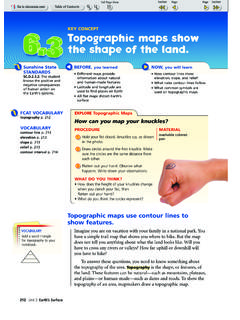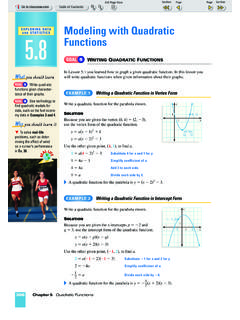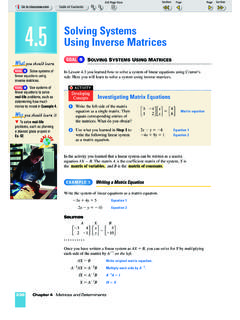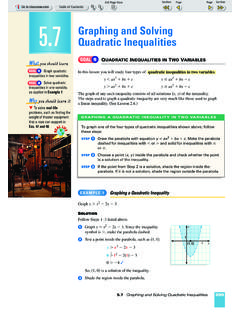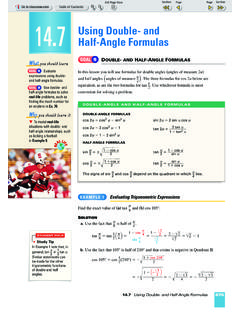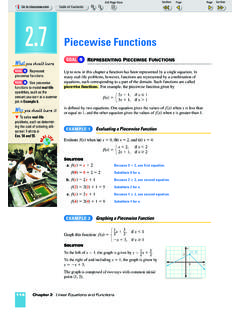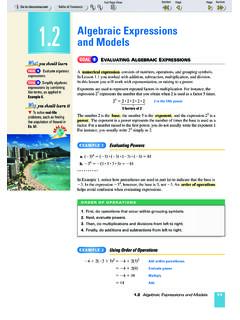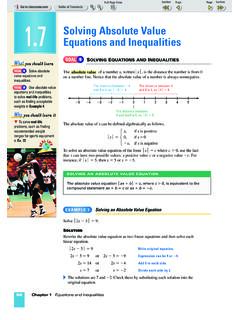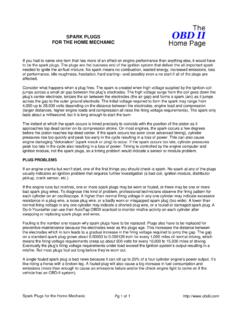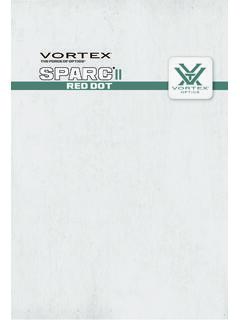Transcription of Infinite Geometric Series - ClassZone
1 Page 1 of 2. Infinite Geometric Series GOAL 1 USING Infinite Geometric Series . What you should learn GOAL 1 Find sums of Consider the following Infinite Geometric Series : Infinite Geometric Series . 1 1 1 1 1. Use Infinite + + + + + .. GOAL 2 2 4 8 16 32. Geometric Series as models Even though this Series has infinitely many terms, it has a finite sum! To see this, of real-life situations, such compute and graph the sum of the first n terms for several values of n. as the distance traveled by a bouncing ball in Example 4. 1 Sn S1 = = 2. Why you should learn it 1 1. S2 = + = To solve real-life 2 4 problems, such as finding 1 1 1 the spending generated by S3 = + + 2 4 8. tourists in Malaysia in 1 1 1 1.
2 Exs. 50 and 51. AL LI S4 = + + + 2 4 8 16. FE. RE. 1 1 1 1 1. S5 = + + + + 2 4 8 16 32 1 2 3 4 5 n Notice that Sn appears to be approaching 1 as n increases. To see why this makes sense, consider the rule for Sn: 1 n . 1 . 1 r Sn = a1 . 1 r =. 1. 2. n . 2. 1. 1 . = 1 . 1 n . 2 . 2. 12 gets closer and closer to 0, which means that S gets closer and As n increases, . n n n closer to 1. The same is true for r provided r is between 1 and 1. Therefore, the formula for the sum of a finite Geometric Series , Sn = a1 . formula below as n increases. 1 r 1 rn , approaches the . THE SUM OF AN Infinite Geometric Series . The sum of an Infinite Geometric Series with first term a1 and common ratio r is given by a1.
3 S= . 1 r provided |r|< 1. If |r| 1, the Series has no sum. THE SUM OF AN Infinite Geometric S. 1.. 2. For the Series described above, the sum is S = 1. = 1, as expected. 1 . 2. Infinite Geometric Series 675. Page 1 of 2. EXAMPLE 1 Finding Sums of Infinite Geometric Series STUDENT HELP Find the sum of the Infinite Geometric Series . NE. ER T . HOMEWORK HELP. 3( )i 1 1 1 1. b. 1 + + .. INT. a. Visit our Web site 4 16 64. i=1. for extra examples. SOLUTION. 1. a. For this Series , a1 = 3 and r = b. For this Series , a1 = 1 and r = . 4. a1 3 a1 1 4. S = = = 10 S = = = . 1 r 1 1 r . 1 . 1. 4. 5. EXAMPLE 2 Finding the Common Ratio An Infinite Geometric Series with first term a1 = 4 has a sum of 10.
4 What is the common ratio of the Series ? SOLUTION. a1. S= Write rule for sum. 1 r 4. 10 = Substitute for S and a1. 1 r 10(1 r) = 4 Multiply each side by 1 r. 2. 1 r = Divide each side by 10. 5. 3. r = Solve for r. 5. The common ratio is r = . 3. 5. EXAMPLE 3 Writing a Repeating Decimal as a Fraction Write .. as a fraction. SOLUTION.. = 18( ) + 18( )2 + 18( )3 + .. a1. = Write rule for sum. 1 r 18( ). = Substitute for a1 and r. 1 STUDENT HELP 18. = Write as a quotient of integers. Study Tip 99. You can check the result 2. in Example 3 by dividing = Simplify. 11. 2 by 11 on a calculator. 2. The repeating decimal .. is as a fraction. 11. 676 Chapter 11 Sequences and Series Page 1 of 2.
5 FOCUS ON. APPLICATIONS GOAL 2 Infinite Geometric Series IN REAL LIFE. EXAMPLE 4 Using an Infinite Series as a Model 8 ft BALL BOUNCE A ball is dropped from a height 10 ft . of 10 feet. Each time it hits the ground, it bounces 8 ft ft ft to 80% of its previous height. ft ft ft . a. Find the total distance traveled by the ball. ft b. On which bounce will the ball have traveled 85% of its total distance ? L. AL I. BALL BOUNCE. FE. RE. 1 2 3 4 5. This photo of a ball SOLUTION Bounce number bouncing was taken with time-lapse photography. The a. The total distance traveled by the ball is: images of the ball get closer together as you move up, d = 10 + 10( ) + 10( ) + 10( )2 + 10( )2 + 10( )3 +.
6 Which means the ball's down up down up down up speed is decreasing. = 10 + 2[10( )] + 2[10( )2] + 2[10( )3] + .. = 10 + 20( ) + 20( )2 + 20( )3 + .. 20( ). = 10 + Excluding first term, find sum of Series . 1 = 10 + 80 Simplify fraction. = 90 Simplify. The ball travels a total distance of 90 feet. b. Let n be the number of up-and-down bounces. The distance dn the ball travels is: 1 ( ) . n dn = 10 + 20( ) . 1 Write rule for dn. down-only sum of n distance up-and-down bounces 11 ( ). (90) = 10 + 20( ) .. n Substitute for dn. = 10 + 16 . 1 . n 1 ( ). Simplify. 1 ( )n Isolate fraction. 0 .2. 1 ( )n Multiply each side by ( )n Isolate exponential expression. log n Solve for n. log The ball travels 85% of its total distance after about 8 up-and-down bounces, or after 9 bounces including the first down-only bounce.
7 Infinite Geometric Series 677. Page 1 of 2. GUIDED PRACTICE. Vocabulary Check 1. Complete this statement: A(n) . ? Geometric Series has infinitely many terms. Concept Check .. 2. Under what conditions will a1r i 1 have a sum? i=1. 3. What two things do you need to know to find the sum of an Infinite Geometric Series ? Skill Check Find the sum of the Infinite Geometric Series . 5 14 . n 1. 1 1 1. 4. 5. 2 + + .. 2 8 32. n=1. Find the common ratio of the Infinite Geometric Series with the given sum and first term. 1 1. 6. S = 6, a1 = 1 7. S = 12, a1 = 2 8. S = 10 , a1 = . 2 2. Write the repeating decimal as a fraction. 9.. 10.. 11.. 12. BALL BOUNCE A ball is dropped from a height of 5 feet.
8 Each time it hits the ground, it bounces one half of its previous height. a. Find the total distance traveled by the ball. b. On which bounce will the ball have traveled 75% of its total distance ? PRACTICE AND APPLICATIONS. STUDENT HELP IDENTIFYING A SUM Decide whether the Infinite Geometric Series has a sum. Explain why or why not. Extra Practice 3 32 5 15 . n 1 n . 3 1 n 1 1 4 n . to help you master skills is on p. 956. 13. 14. 15. 16.. 2 3 4 3. n=1 n=0 n=1 n=0. FINDING SUMS Find the sum of the Infinite Geometric Series if it has one. 12 3 23 12 . n n n 1 . 17. 18. 19. 20. 2. (2)n 7. n=0 n=0 n=1 n=0. 4 14 110 2 65 4 37 . n n 1 n n 21. 22. 23. 24. n=0 n=1 n=0 n=0. 18 12 12 25 121.
9 N n 1 . 3 n n 1. 25. 26. 27. 1.. 12 25. 28. n=0 n=1 n=0 n=1. STUDENT HELP. FINDING COMMON RATIOS Find the common ratio of the Infinite Geometric HOMEWORK HELP Series with the given sum and first term. Example 1: Exs. 13 28 29. S = 4, a1 = 1 30. S = 10, a1 = 1 31. S = 12, a1 = 3. Example 2: Exs. 29 37. Example 3: Exs. 38 46 32. S = 8, a1 = 2 33. S = 6, a1 = 2 34. S = 50, a1 = 4. Example 4: Exs. 47 51. 1 1 11 2. 35. S = , a1 = 36. S = , a1 = 1 37. S = 2 , a1 = 4. 9 6 13 9. 678 Chapter 11 Sequences and Series Page 1 of 2. WRITING REPEATING DECIMALS Write the repeating decimal as a fraction. 38.. 39.. 40.. 41.. 42.. 43.. 44.. 45.. 46.. 47. PENDULUM A pendulum is released to swing freely.
10 On the first swing, the pendulum travels a distance of 18 inches. On each successive swing, the pendulum travels 90% of the distance of the previous swing. What is the total distance the pendulum swings? After how swing 1. 18. many swings has the pendulum traveled 80% swing 2. 18( ). of its total distance ? swing 3. 18( )2. 48. WINDOWS Some types of incoming sunlight I. windows are constructed with two 2 I. I. parallel panes of glass, each of which I I 4. I. reflects half of the sunlight that 2 4. 8 I. hits it from either side. The other I 16. I 16 I. half of the sunlight passes through 8 32 I. 64. the pane. How much of the sunlight I I.. 32 64. will pass through both panes?
